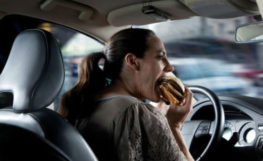
In the intricate mosaic of our daily lives, the act of driving often becomes an ingrained aspect, a routine that seamlessly blends into the fabric of our existence. However, within this seemingly mundane activity lies a complex dance of behaviors that can have profound consequences, not just for the individual driver but for the collective safety and well-being of everyone on the road. Bad driving habits, seemingly innocuous at first glance, have the potential to sow the seeds of chaos, posing threats not only to the driver but to the very essence of road safety. It’s easy to dismiss these habits as minor inconveniences or quirks of the road, but the truth is that they are powerful catalysts for accidents, injuries, and even fatalities.
The purpose of this exploration is to peel back the layers of these seemingly harmless habits, to scrutinize and understand their nuances, and to shed light on the far-reaching impact they can have on our lives and the lives of those with whom we share the road. Each negligent turn of the wheel, every moment of distraction, and each time we succumb to the allure of speed beyond limits contributes to a narrative that jeopardizes the fundamental principle of road safety. This exploration seeks not to condemn but to illuminate, to unravel the intricacies of bad driving habits, and to underscore the urgent need for a collective awakening.
As we navigate through the chapters of this examination, we’ll encounter ten prevalent bad driving habits, each with its own set of risks and potential consequences. It’s not just about identifying these habits but about comprehending the subtle interplay between actions and their repercussions. For only when we truly understand the gravity of these habits can we hope to inspire change, to forge a path toward safer roads and responsible driving.
This exploration is an invitation to introspection, a call to action for every driver to examine their own habits behind the wheel. It is a recognition that the road is a shared space, and our actions on it reverberate beyond the confines of our vehicles. The journey toward safer roads begins with acknowledging the impact of our behaviors, and this examination aims to be the compass guiding us on that journey.
So, buckle up as we embark on this expedition through the realm of bad driving habits. Let’s unravel the complexities, confront the realities, and emerge on the other side with a deeper understanding of the role we play in shaping the safety of our roads. Through awareness and collective commitment, we can transform our roads into havens of security, where each journey is not just a destination but a testament to responsible, considerate, and safe driving.
Driving is a ubiquitous activity in modern society, an essential means of transportation for millions of people worldwide. Whether it’s commuting to work, running errands, or embarking on road trips, driving has become deeply ingrained in our daily routines. Yet, amidst the hustle and bustle of our busy lives, it’s easy to overlook the significance of our actions behind the wheel and the potential consequences they may entail.
One of the most common bad driving habits is distracted driving. In today’s hyper-connected world, smartphones, GPS devices, and in-car entertainment systems compete for our attention while driving. Despite numerous campaigns and awareness efforts highlighting the dangers of distracted driving, many motorists continue to engage in activities like texting, browsing social media, or even watching videos while driving. These distractions divert attention away from the road, significantly increasing the risk of accidents.
Another prevalent bad driving habit is aggressive driving. This includes behaviors such as tailgating, weaving in and out of traffic, and excessive speeding. Aggressive drivers often disregard traffic laws and exhibit hostility towards other road users, creating an unsafe environment for everyone. Road rage incidents, which can escalate into dangerous confrontations, are frequently associated with aggressive driving behaviors.
Driving under the influence of alcohol or drugs remains a significant concern despite stringent laws and public awareness campaigns. Impaired driving not only impairs judgment and reaction time but also significantly increases the likelihood of accidents. Even a small amount of alcohol or drugs can impair driving abilities and compromise road safety.
Fatigue is another common factor contributing to bad driving habits. Many drivers underestimate the impact of fatigue on their ability to operate a vehicle safely. Fatigued driving can impair cognitive function, decrease alertness, and increase the likelihood of microsleep episodes, where drivers briefly nod off behind the wheel. Long hours of driving without adequate rest breaks, especially during late-night or early-morning hours, significantly elevate the risk of accidents due to drowsiness.
Failure to use seat belts is a concerning habit that compromises personal safety on the road. Seat belts are one of the most effective safety devices in vehicles, yet some drivers and passengers choose not to wear them, putting themselves at unnecessary risk of injury or death in the event of a crash. Despite laws mandating seat belt use in many jurisdictions, compliance rates vary, and some individuals continue to disregard this crucial safety measure.
Poor lane discipline is another bad driving habit that contributes to congestion and increases the likelihood of accidents. Drivers who frequently change lanes without signaling or fail to maintain a consistent speed disrupt the flow of traffic and create hazardous conditions. Proper lane discipline, including using turn signals, maintaining a safe following distance, and staying in the correct lane for your intended route, is essential for safe and efficient driving.
Ignoring traffic signals and signs is a dangerous habit that can have severe consequences. Running red lights, disregarding stop signs, and failing to yield the right of way contribute to a significant number of accidents each year. These violations not only endanger the driver but also other road users, including pedestrians and cyclists. Respecting traffic signals and signs is essential for maintaining order and safety on the road.
Tailgating, or following other vehicles too closely, is a bad driving habit that increases the risk of rear-end collisions. Tailgating reduces the driver’s ability to react to sudden changes in traffic conditions, such as sudden stops or obstacles in the road. It also creates a sense of pressure and anxiety for the driver being tailgated, potentially leading to aggressive or erratic behavior.
Driving with defective equipment, such as worn-out tires or malfunctioning brakes, is a dangerous habit that compromises vehicle safety. Many drivers neglect routine maintenance checks or postpone necessary repairs, putting themselves and others at risk of accidents. Proper maintenance and timely repairs are essential for ensuring that vehicles are in optimal condition for safe operation on the road.
Finally, engaging in risky behaviors such as street racing or stunts is a dangerous habit that endangers not only the driver but also bystanders and other road users. These reckless behaviors often occur in urban areas or on highways, where drivers seek thrills and adrenaline rushes at the expense of safety. Street racing incidents and stunt driving maneuvers can lead to catastrophic accidents with devastating consequences.
Bad driving habits encompass a wide range of behaviors that compromise road safety and endanger the lives of motorists, passengers, pedestrians, and cyclists. From distracted driving and aggressive behaviors to impaired driving and disregard for traffic laws, these habits have far-reaching consequences that extend beyond individual drivers. Addressing these habits requires a multi-faceted approach involving education, enforcement of traffic laws, and promoting responsible driving behaviors. By raising awareness, encouraging accountability, and fostering a culture of safety on the roads, we can work towards creating a safer environment for all road users.
Talking on Cell Phone
We have all been a victim of this driving habit where the person in front of you continuously flashes their brake lights, over corrects their steering or takes forever to go when the light turns green. You pass them up only to find that they are on their cell phone, putting on makeup or eating a burger. Don’t be ‘that guy’ and save the texting, eating or whatever else you find necessary to do while driving for later.
Driving Too Fast For Road Conditions
Whether it’s foggy outside, raining or even snowing (not exactly an issue in South Texas) there is always that one car that seems to be invincible to the elements and continues to drive the normal speed limit or faster when it really calls for slower, more cautious driving. It is not only annoying, but extremely dangerous to drive recklessly in weather that is hard to see in. Depending on the circumstances your vehicle may not grip the road as it normally would and can cause a serious collision if not driven properly. Take caution during bad weather, it’s not worth arriving a few minutes early when there is a slight chance of not arriving at all.
Not Signaling When Changing Lanes
This is a very common habit of most drivers that can lead to road rage, a ticket, or even a collision. Use your signal light as necessary to alert other drivers of your intentions. That also doesn’t mean to switch on your turn signal after you already started to switch lanes.
Leaving High Beams On
There are places and circumstances that call for high beams, cruising down Ocean Drive is not one of them. There is nothing more irritating than driving down the road and being blinded by a light almost a mile away. Be considerate of other drivers and try to routinely check your dashboard to make sure your high beams aren’t on.
Taking Two Spaces in a Parking Lot
If you are afraid that someone might hit your car so you decide to park in two spots instead, trust me, this is not the greatest approach. If you are worried about the well-being of your vehicle, then park at the very back or on the far side of the parking lot away from vehicle and pedestrian traffic.
Straddling the Line
This common habit is when someone drives in the middle of two lanes and can’t seem to figure which one to choose. This is extremely dangerous and impedes the flow of traffic making it difficult for someone to pass. As a rule of thumb, try to position yourself behind the car in front of you to where your seat is directly behind theirs.
Tailgating
I think we can all agree that this is perhaps the most annoying habit a driver can have. Tailgating is a serious occurrence that leads to over 2,000 deaths and about 950,000 injuries a year. You should always leave at least one cars length in between you and the car in front and behind you. By creating this space you can allow yourself time to react, and protect yourself from being hit in the case you need to suddenly brake.
Creeping Forward at a Red Light
Did no one ever play ‘red light, green light’ as a child? You don’t creep forward if the person says red light! You stop directly in your tracks and wait until they say green light. It is no different in a car at a traffic light. If the light is red, you are to make a complete stop. Rolling forward can cause other drivers to assume the light is green and mistakenly take off or worse another vehicle can hit yours as they turn to your side of the road. There’s a reason for the broad white stripe in front of the traffic lights. It’s for you to know where to stop. Pedestrians crossing should have ample room and not worry about traffic moving closer just because you’re an eager beaver.
Honking
My car sounds like the roadrunner when I honk, so I tend to rarely use it except when absolutely necessary. However, others seem to avidly use theirs in any situation they can. Whether they are in traffic, waiting at a light, or simply expressing their road rage, people use their horn as an expression of how they are feeling as opposed to using it for what it’s actually for. Using your horn when it doesn’t call for it causes others to panic and others to become angry. Don’t be the cause of another road rage news article and instead use your horn only when absolutely necessary.
Rubbernecking
“It’s not polite to stare.” It seems your mother was right on this one folks. Nobody enjoys being in an accident, having to change a tire on the side of the road, or getting a ticket. Having people gawk at them from the highway doesn’t make it any better. Not only does this slow down the flow of traffic, but when people stare at an accident or any other commotion on the side of a road it can lead to further collisions and create a bumper to bumper effect or worse, a pile-up.
Bottom line: Drop these habits! Be smart, and drive safe!
CONTACT HERRMAN & HERRMAN P.L.L.C. AT 361.882.4357
Our firm has over 100 years of combined experience handling personal injury cases across Texas. Our outstanding record of favorable settlements and verdicts includes over 20,000 successfully resolved cases. Once we take on a case, we are relentless, and you can rely on us to pursue full compensation for you.
- You can trust our attorneys to be compassionate and professional.
- We will fight hard to obtain a fair settlement for you.
- Our firm represents the injured and families who have lost a loved one due to the negligent acts of others.
- We serve as counsel in various injury cases – including car, truck, motorcycle, bicycle, and pedestrian accidents, premises liability cases, product liability cases, and medical malpractice claims.
- We can dispatch the Herrman & Herrman Accident Investigative Team to the crash scene to start an investigation and preserve critical evidence.
ABOUT HERRMAN & HERRMAN PERSONAL INJURY LAWYERS
With over 100 years of combined experience among the legal team of Herrman & Herrman, P.L.L.C., our Texas personal injury attorneys have successfully resolved over 20,000 cases. When representing injured Texas residents, we fight for justice against wrongdoing and aggressively pursue the best resolution to complex personal injury claims.
If you or a loved one was injured, please get in touch with us for a free initial consultation and case evaluation. Herrman & Herrman, P.L.L.C., is a locally based law firm that holds negligent individuals and companies accountable for their wrongdoing. We are not a personal injury mill that advertises nationwide. We provide individualized advocacy in attending to all aspects of claims that involve. Our firm has offices in the following locations: Corpus Christi, Corpus Christi South Side, Brownsville, McAllen, San Antonio, Houston, and Ft. Worth, TX.
We remain by our client’s side, handling all aspects of their claims and attending to all legal, medical, and financial needs. That dedication combines experience, legal knowledge, and insight from a former insurance adjuster and several former insurance defense attorneys. Whether our clients suffer from physical pain from an accident or the emotional grief of death, we treat clients with compassion. We put their mind at ease during difficult times by answering their questions concerning the length of their claim, medical bills, financial compensation, and their overall need for a lawyer.








